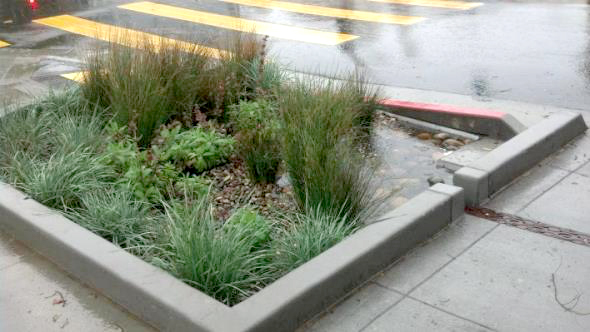
San Francisco is a national leader in sustainable urban development, having passed citywide ordinances on mandatory green building, recycling, and environmental ethics. To bring this same ethos to the complex subject of urban water management, the City has incorporated a number of “Green Infrastructure” (GI) projects into its massive, multi-billion dollar Sewer System Improvement Program (SSIP). To ensure the success of the municipal GI projects, the City provides contractor training on design guidelines and best practices. To date, 40 firms have completed the training program, including Madroño Landscape Design Studio. But unlike many of the larger firms which are engaged in more commercial and municipal projects, Madroño’s residential business sees the SSIP as a launching pad to engage private property owners more deeply in the larger vision of greening our city.
So what is Green Infrastructure? In essence, it is a landscaping strategy that diverts rain into planted areas and eventually back into the water table, rather than sending it into the sewer. This method replaces impermeable surfaces like asphalt and concrete with permeable pavers and infiltration basins that allow rain water to percolate into the earth. Less water in the sewer means lower treatment costs for the city, less chance of overwhelmed sewers, and an overall recharging of the water table for improved plant and soil health. The City has found that optimal GI design prevents nearly 90% of stormwater from entering the sewer system.
But Raphael Garcia, the Public Utilities Commission (PUC) GI Project Manager, spoke of the challenges still facing this issue: “Municipal projects can only go so far, as 80% of the impervious surfaces in this city are on private property.” This eye-opening statistic raises the question: what programs are in place to reach this vast and largely unaddressed majority of the city landscape?

Rosey Jencks, SF's Urban Watershed Management Program Lead, pointed out two current initiatives to transform water management on a residential level. The Stormwater Management Ordinance requires projects that create or replace large areas of impervious surface to install measures reducing runoff, to prevent water from entering the sewer system. And the Urban Watershed Stewardship Grant program engages nonprofits and schools by providing $200,000 in annual funding to implement GI projects like bioswales and rain gardens.
Jencks also noted that there is an ongoing debate of how to spend the remaining $343 million allocated to the GI program most effectively. The PUC is considering a range of options, from investing more in construction and grant programs to a modified billing system that reduces wastewater rates for residents who increase the percentage of permeable surface on their properties. In the past, SF has financed green energy projects in a similar way, supplying up-front costs for solar and wind projects to be repaid over time by savings on consumer electric bills. This method has expanded through the current CaliforniaFIRST program, which encompasses a wider variety of projects, including Green Infrastructure.
Another method would be to offer rebates or tax credits on private GI projects, as the state of California has done with its Turf Replacement Rebate. By reducing the cost of residential projects through rebates, the City can significantly expand the amount of private investment in Green Infrastructure, and in turn, the land that it impacts. Upgrading to a water-harvesting system from a standard roof-sewer connection becomes a lot more attractive with a government rebate. Without the discount, a homeowner may not spend anything since the project cannot be done partially. By sharing home improvement costs, the City can actually reduce public water management spending through widespread replacement of impervious surfaces.
As a property owner, you too can make a difference. Call your district supervisor to support funding for residential Green Infrastructure! Or ask Madroño for a quote to demolish the concrete in your back yard and replace it with permeable pavers and water-wise California native plants. We're here to help.

